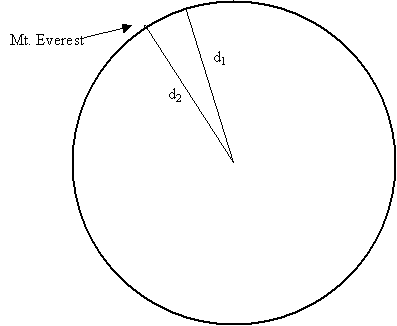Competency #10 & #1
Answer and Explanation

Between the time when the ball left Castillo's bat and when it reached its peak, did the force of gravity between the ball and the earth significantly change? Explain.
![]() Answer:
Answer:
The force of gravity between the ball and the earth decreased, but did not decrease significantly.
The distance between the ball and earth increased. The force of gravity is inversely related to the distance between the two objects; this means that the force of gravity decreased as the ball went upward.
However, did the force of gravity change significantly? To answer that, we must ask ourselves if the distance between the ball and the earth changed significantly. A scale diagram of the earth is shown below:

Mt. Everest is drawn in about 3 times bigger than it really should be, based on the scale used. You can draw a scale model yourself by drawing a circle with a 5 cm radius (10 cm diameter) and then drawing a triangle with a height of 1/3 of a millimeter to represent Mt. Everest.
When applying Newton's Law of Universal Gravitation, the distance used is from the center of one object to the center of the other object. In the above picture, d1 represents the distance from the earth to a baseball at sea level and d2 represents the distance from the earth to a baseball on the top of Mt. Everest. As you can see, there is not a significant difference between these two. This leads us to the conclusion that the force of gravity on the baseball, while decreasing as the ball rises into the air and increasing as the ball comes back toward earth, is essentially constant during the balls entire flight.
Additional exercise: With the below information, calculate the force of gravity for a ball at sea level and a ball 100 m above the earth.
Mass of baseball = 0.14 kg Mass of earth = 5.98 x 1024 kg Earth radius = 6.36 x 106 m G = 6.67 x 10 -11 N m2/kg2